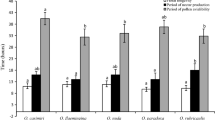Summary
The adult behavior of the yucca moth, Tegeticula maculata Riley, is finely tuned to the reproductive biology of its specific host plant, Yucca whipplei Torr. The female moths oviposit in the ovaries of the yucca flowers and actively pollinate the same flowers with pollen which they have collected previously. The selective pressures imposed on the moths by 1) the plant's need for pollen transfer via an insect pollinating agent, 2) its partial self-incompatibility, and 3) its ability to regulate seed set by aborting excess fruits, have molded the pollinator's behavior in such a way that its offspring have the greatest possible chance of surviving through the early larval stages. The evolutionary responses of the pollinator include the following: 1) the female moths consistently fly to a different plant after collecting pollen, thus insuring cross-fertilization of the flowers, 2) they always pollinate after depositing the first egg in a flower, but not necessarily after subsequent ovipositions, and 3) females emerging near the end of the flowering season frequently oviposit in developing seed pods, as opposed to open flowers which are more likely to be aborted by the plants.
Similar content being viewed by others
References
Coquillett DW (1893) On the pollination of Yucca whipplei in California. Insect Life 5:311–314
Davis DR (1967) A revision of the moths of the subfamily Prodoxinae (Lepidoptera: Incurvariidae). Washington DC: US Nat Museum Bull 255
Engelmann G (1872a) The flower of Yucca and its fertilization. Bull Torrey Bot Club 3:33
Engelmann G (1872b) Note. Bull Torrey Bot Club 3:37
Gilbert N, Gutierrez AP, Frazer BD, Jones RE (1976) Ecological relationships. WH Freeman and Co Reading-San Francisco
Gutierrez AP, Butler GD, Jr, Wang Y, Westphal D (1977) The interaction of pink bollworm (Lepidoptera: Gelichiidae), cotton, and weather: A detailed model. Can Ent 109:1457–1468
Holling CS (1966) The functional response of invertebrate predators to prey density. Mem Ent Soc Can 48:1–86
Krebs JR, Davies NB (1978) Behavioral ecology: An evolutionary approach. Sinauer Assoc Sunderland Mass
McLaughlin JR (1974) Bionomics of the pink bollworm, Pectinophora gossypiella (Saunders) in the southern desert region of California. PhD Thesis, University of California, Riverside
Munz PA (1959) A California flora. University of California Press Berkeley-Los Angeles-London
Powell JA, Mackie RA (1966) Biological interrelationships of moths and Yucca whipplei (Lepidoptera: Gelechiidae, Blastobasidae, Prodoxidae). Univ Calif Pub Ent 42:1–59
Prokopy RJ (1975) Oviposition-deterring fruit marking pheromone in Rhagoletis fausta. Env Ent 4:298–300
Rau P (1945) The yucca plant, Yucca filamentosa, and the yucca moth, Tegeticula (Pronuba) yuccasella (Riley): An ecologico-behavior study. Ann Mo Bot Gard 32:373–394
Riley CV (1872) Insect shaped by the needs of flowers. In: Anonymous, Report on Amer Assoc Adv Sci, Dubuque, Iowa, August, 1872 meeting. Nature 6:444
Riley CV (1881) Further notes on the pollination of yucca and on Pronuba and Prodoxus. Proc Amer Assoc Adv Sci 1880:617–639
Riley CV (1892a) The yucca moth and yucca pollination. Rep Mo Bot Gard 3:99–159
Riley CV (1892b) Some interrelations of plants and insects. Proc Biol Soc Wash 7:81–104
Riley CV (1893) Further notes on yucca insects and yucca pollination. Proc Biol Soc Wash 8:41–54
Rothschild M, Schoonhoven LM (1977) Assessment of egg load by Pieris brassicae (Lepidoptera: Pieridae). Nature 266:352–355
Snedecor GW, Cochran WG (1967) Statistical methods. The Iowa State Univ Press, Ames Iowa
Trelease W (1893) Further studies of yuccas and their pollination. Rep Mo Bot Gard 4:181–226
Udovic JD, Aker CL (1981) Fruit abortion and the regulation of fruit number in Yucca whipplei. Oecologia (Berl) 48:389–399
Wimber DR (1958) Pollination of Yucca whipplei Torr. MA Thesis, Claremont Graduate School, Claremont, Calif
Author information
Authors and Affiliations
Rights and permissions
About this article
Cite this article
Aker, C.L., Udovic, D. Oviposition and pollination behavior of the yucca moth, Tegeticula maculata (Lepidoptera: Prodoxidae), and its relation to the reproductive biology of Yucca whipplei (Agavaceae). Oecologia 49, 96–101 (1981). https://doi.org/10.1007/BF00376905
Received:
Issue Date:
DOI: https://doi.org/10.1007/BF00376905




